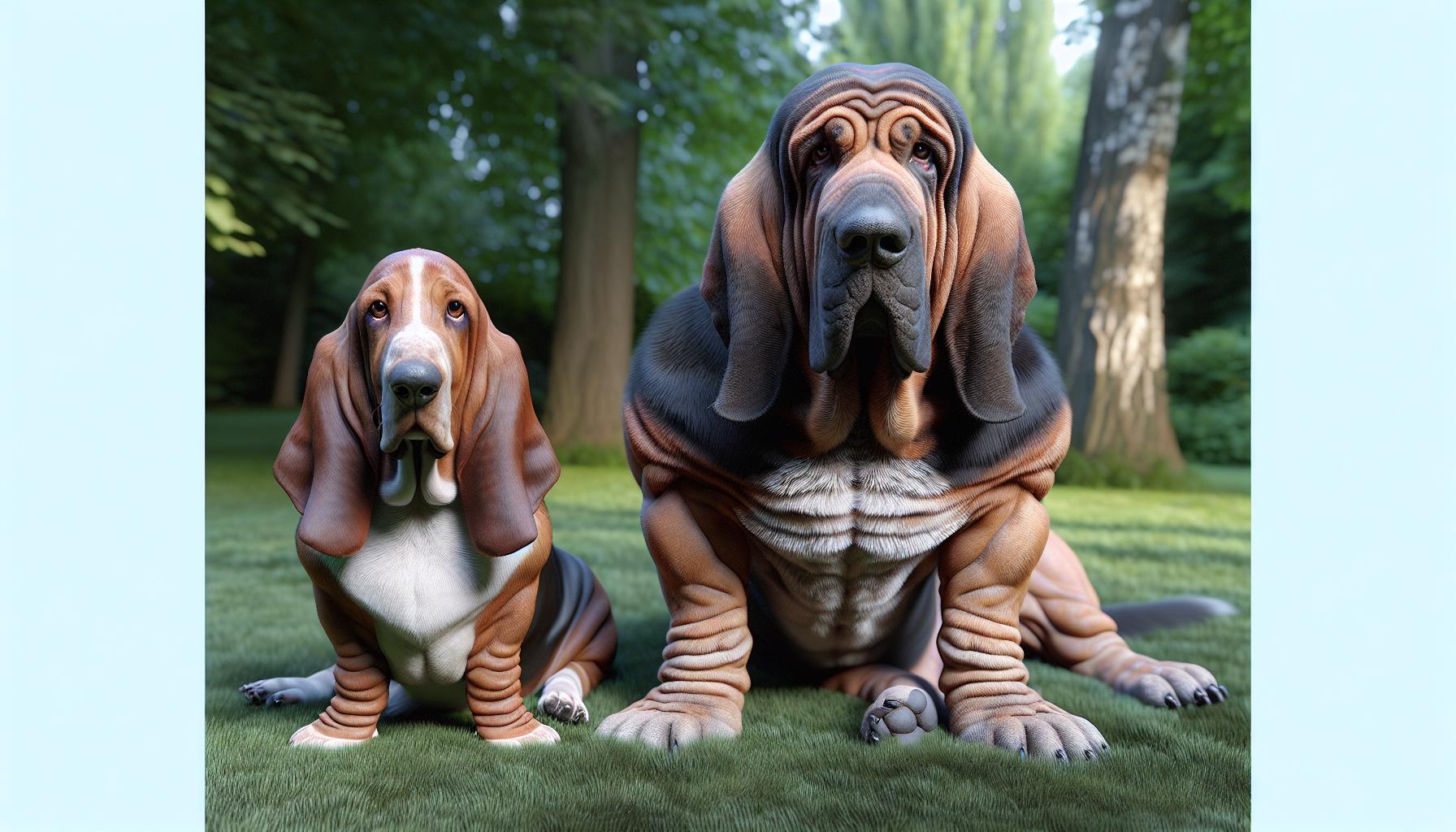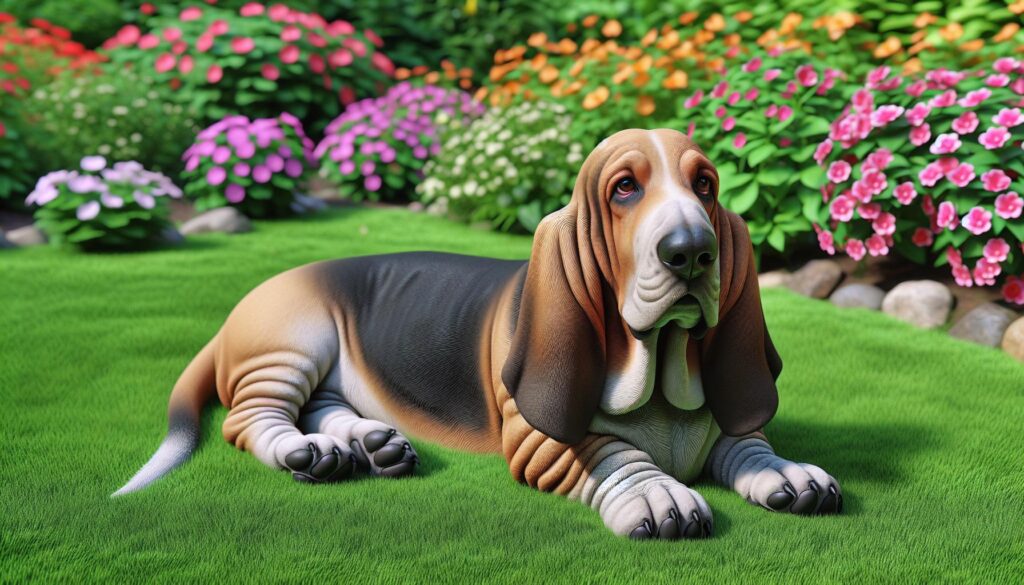When it comes to lovable and laid-back dogs, the Basset Hound truly stands out. With their droopy ears and soulful eyes, these gentle giants have captured the hearts of many. But how does this charming breed compare to its distant cousin, the Bloodhound? Both breeds share a rich history and a keen sense of smell, making them exceptional companions for tracking and hunting.
In this article, I’ll dive into the fascinating similarities and differences between Basset Hounds and Bloodhounds. From their unique physical traits to their distinct temperaments, understanding these breeds can help you appreciate their charm even more. Whether you’re a seasoned dog owner or considering adding one of these breeds to your family, there’s plenty to discover about these remarkable hounds.
Key Takeaways
- Physical Differences: Basset Hounds are smaller and stockier, with droopy ears and a calm demeanor, while Bloodhounds are larger, robust, and known for their exceptional tracking abilities.
- Temperament Traits: Basset Hounds are laid-back and affectionate, making them great family pets, whereas Bloodhounds are independent, strong-willed, and require consistent training and socialization.
- Training Techniques: Both breeds benefit from positive reinforcement; however, Basset Hounds prefer short training sessions and engagement through play, while Bloodhounds require clear leadership and scent-based training activities.
- Health Awareness: Be mindful of breed-specific health concerns; Basset Hounds may face hip dysplasia and obesity, while Bloodhounds are prone to bloat and ear infections.
- Common Ancestry: Both breeds share a rich history and are recognized for their hunting and tracking capabilities, highlighting their ties despite differences in size and function.
Basset Hound:vip4asedgjc= Bloodhound
Basset Hounds are known for their distinctive droopy ears, long bodies, and soulful eyes. Their calm demeanor makes them excellent companions. Weighing between 40-65 pounds, they typically stand 14-15 inches tall. Basset Hounds possess a good-natured temperament, showing a playful yet relaxed attitude.
Bloodhounds, on the other hand, boast a powerful sense of smell, making them exceptional tracking dogs. With a weight range of 80-110 pounds and a height of 21-27 inches, their build is more robust than that of Basset Hounds. Bloodhounds are friendly but can be independent, often following their noses leading to a strong instinct for exploration.
Both basset hound:vip4asedgjc= bloodhound share a common ancestry, dating back to ancient times. They’ve been employed in search and rescue operations due to their keen olfactory skills. Basset Hounds excel in companionship roles, while Bloodhounds serve in tracking and police work, showcasing their varying suitability for different environments.
Physical Characteristics

Basset Hounds and Bloodhounds demonstrate distinct physical traits that set them apart yet highlight their shared ancestry. Understanding basset hound:vip4asedgjc= bloodhound unique attributes emphasizes their suitability for varying roles as pets and working dogs.
Basset Hound Traits
Basset Hounds possess several defining physical characteristics. Their long, droopy ears enhance their keen sense of smell. Basset Hounds typically weigh between 40-65 pounds and reach a height of 14-15 inches at the shoulder. Their bodies feature a short, stocky build with a proportionally long back, accented by thick skin that often displays loose folds. They have a distinctive, expressive face, highlighted by large, soulful eyes that convey their gentle temperament. A Basset Hound’s coat varies in color, commonly appearing in combinations of tri-color, lemon, or red.
Bloodhound Traits
Bloodhounds exhibit robust physical characteristics, essential for their tracking abilities. Weighing between 80-110 pounds and measuring 21-27 inches tall, they showcase a strong, muscular frame. Their skin is loose and drapes over their bodies, providing protection and flexibility when navigating difficult terrain. Bloodhounds feature long, drooping ears that help capture scent particles, and their deep, expressive wrinkles enhance their character. Their coats are short and come in colors like black and tan, liver and tan, or red. These traits contribute to their impressive tracking skills, making them valuable assets in search and rescue operations.
Temperament Comparison

Both Basset Hounds and Bloodhounds possess unique personalities that reflect their distinct roles as companions and working dogs. Understanding basset hound:vip4asedgjc= bloodhound traits helps potential owners choose the right breed for their lifestyle.
Basset Hound Personality
Basset Hounds are known for their calm, affectionate nature. They thrive on companionship and enjoy spending time with their families. Their gentle temperament makes them suitable for homes with children and other pets. Basset Hounds often exhibit a laid-back attitude, making them less demanding in terms of exercise compared to more active breeds. While they are playful, they’re equally content lounging around, often displaying a charming stubbornness that can make training a challenge.
Bloodhound Personality
Bloodhounds are characterized by their strong-willed and independent nature. Their tracking instincts drive them, often leading them to explore their surroundings. This independent behavior can make them less suited for new dog owners, as Bloodhounds require consistent training and socialization from an early age. Despite basset hound:vip4asedgjc= bloodhound determination, Bloodhounds are friendly and gentle with children, showcasing a loving side when properly nurtured. Their loyalty and intelligence make them excellent companions, though their strong scenting abilities can lead them astray if not closely monitored.
Training and Socialization

Effective training and socialization are essential for both Basset Hounds and Bloodhounds to thrive in different environments. Both breeds benefit from positive reinforcement techniques, accommodating basset hound:vip4asedgjc= bloodhound unique temperaments and learning styles.
Basset Hound Training Tips
- Utilize Positive Reinforcement: Reward behaviors with treats and praise, encouraging cooperation and willingness.
- Keep Sessions Short: Limit training to 5-10 minute intervals. Basset Hounds can lose focus easily, so brief sessions work better.
- Be Consistent: Use the same commands and cues each time. Consistency helps Basset Hounds understand what’s expected.
- Incorporate Play: Engage Basset Hounds with fun activities during training. This breed responds well to playful training methods.
- Socialize Early: Introduce Basset Hounds to various environments, people, and pets to cultivate confidence and reduce anxiety.
- Establish Leadership: Assertive leadership is crucial. Bloodhounds thrive under guidance, requiring clear boundaries.
- Focus on Commands: Teach basic commands such as sit, stay, and come. Mastering these lays a firm foundation for further training.
- Emphasize Leash Training: Given their strength and tracking instincts, leash training is critical. Avoid pulling, as this can lead to leash aggression.
- Engage in Scent Work: Incorporate scent-based activities. Bloodhounds enjoy using their noses, making tracking games a perfect training tool.
- Socialize Regularly: Expose Bloodhounds to various situations and people. Early and continuous exposure develops their adaptability and reduces fear-based behaviors.
Health Considerations
Both Basset Hounds and Bloodhounds encounter specific health issues that potential owners should be aware of. Understanding these considerations helps ensure their well-being.
Common Health Issues in Basset Hounds
Basset Hounds face several common health issues:
- Hip Dysplasia: This genetic condition affects the hip joint, leading to arthritis and mobility problems. Regular veterinary check-ups help catch any signs early on.
- Ear Infections: Their long, droopy ears can trap moisture, leading to infections. Routine ear cleaning and inspection minimize this risk.
- Obesity: Basset Hounds have a propensity to gain weight. Monitoring their diet and ensuring regular exercise maintains a healthy weight.
- Dermatitis: This skin condition arises from allergens or irritants. Regular grooming and checking for irritants can help prevent flare-ups.
- Eye Problems: Conditions such as cataracts and glaucoma are more prevalent in this breed. Regular eye examinations catch these issues before they worsen.
- Hip and Elbow Dysplasia: Like Basset Hounds, they are prone to hip and elbow dysplasia, resulting in joint pain and mobility issues. Genetic testing for breeding can help mitigate this risk.
- Bloat: This life-threatening condition occurs when the stomach fills with gas and twists. Feeding smaller, more frequent meals and avoiding exercise post-meal reduces the risk.
- Skin Conditions: Their loose skin may trap moisture, leading to infections or irritations. Keeping their skin clean and dry is crucial.
- Ear Infections: Their long ears can also lead to frequent ear infections. Regular ear checks and cleaning minimize potential issues.
- Eye Disorders: Conditions like ectropion (eyelids turning outward) and entropion (eyelids turning inward) can occur. Routine veterinary eye assessments help address these disorders promptly.
Appreciation For These Wonderful Dogs
Basset Hounds and Bloodhounds are truly remarkable breeds each with their own unique charm. I’ve enjoyed exploring their differences and similarities and I hope you’ve gained a deeper appreciation for these wonderful dogs. Whether you’re drawn to the affectionate nature of Basset Hounds or the impressive tracking skills of Bloodhounds there’s no doubt that basset hound:vip4asedgjc= bloodhound breeds make incredible companions.
As you consider adding one of these lovable pups to your family remember the importance of understanding their specific needs and characteristics. With the right care training and love both breeds can thrive and bring joy to your life.



